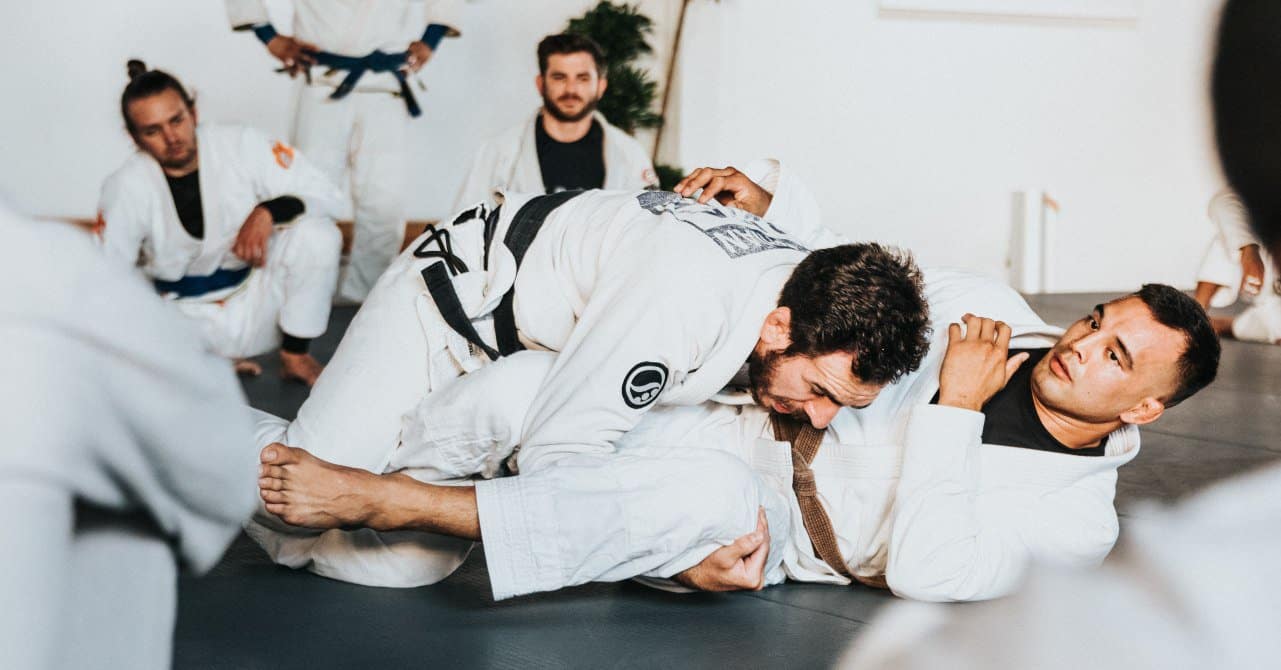Jiu-jitsu is a type of martial arts that can be used in close combat for self-defense. Generally, there are two different types of Jiujitsu. They are Brazilian jiu-jitsu (BJJ) and Japanese jujutsu. Over the years, many people across the world have been guilty of confusing the two martial arts to mean the same thing – this is mostly because the two martial arts have the same name; “Jiujitsu”.
But, here’s a burning question; are there significant differences and similarities between Brazilian jiu-jitsu and Japanese jujutsu?
The main similarity between BJJ and Japanese Jujutsu is that they both focus on the idea of defeating stronger opponents with a flexible fighting strategy. The difference is that BJJ focuses on ground fighting and submission grappling, while Japanese jujutsu focuses on throwing opponents and joint manipulation.
Although both martial arts have their similarities, there are several ways in which you can differentiate between the two of them. In the rest of this post, we’ll be further sharing with you everything that you need to know about Brazilian jiu-jitsu and Japanese jujutsu. Doing this will enable you to easily decide on which of them is right for you in case you are not sure. So, without further ado, let’s get straight down to business.
What Are The Differences Between Brazilian Jiu-Jitsu And Japanese Jujutsu?
As earlier mentioned, one of the differences between Brazilian jiu-jitsu and Japanese jujutsu can be seen from the way attacks are launched in the two martial arts. Apart from that, there are also a few other differences between them. These can be seen from the opportunities that both of the arts offer, belt systems, clothes, equipment, and training. Now, let’s take them one at a time and see how both martial arts compare.
Both martial arts have different rules
The key difference in their rules is that BJJ doesn’t involve strikes while Japanese jujutsu requires strikes. Here’s what you need to know about their rules below.
BJJ
Speaking of the most popular form of jiu-jitsu – “Brazilian jiu-jitsu” – it primarily focuses on self-defense, using two key techniques. These are ground fighting and grappling.
But, here’s a question; what is ground fighting and grappling in BJJ? First, it’s worth noting that ground fighting and grappling are sometimes used interchangeably. However, there’s a slight difference between them.
Generally, ground fighting is hand-to-hand combat that happens when two fighters are on the ground. BJJ’s Ground fighting occurs when both combatants are at a pretty close range, on the ground. As far as grappling is concerned, it primarily involves gripping the opponent on the ground. It doesn’t require striking, instead, it involves using various moves to cause injury to the opponent.
Here’s a better illustration; In Brazilian jiu-jitsu, a match begins with combatants standing up. However, as quickly as the match begins, there’s a takedown, where the fighters take the fight to the ground.
On the ground, the fighters use different moves to score points. BJJ may end in submission – a situation where a competitor accepts defeat after his/her opponent has taken full control on the ground, using certain holds; joint locks, and chokes.
Here’s a brief on how points are scored in a BJJ match.
- Mount – 4 points
- Back control – 4 points
- Guard pass – 3 points
- Takedowns – 2 points
- Knee-on-belly position – 2 points
- Sweeps – 2 points
Japanese jujutsu
As for the oldest form of jiu-jitsu – “Japanese jujutsu” – it primarily focuses on self-defense by using various techniques, such as throwing opponents and joint manipulation. Furthermore, the martial art also makes use of other strategies, such as strangling, choking, striking, and blocking.
In the traditional Japanese jujutsu, a match usually involves three stages. These are the striking stage, grabbing stage (takedown), and ground fighting.
Here’s a better illustration; in a Japanese jujutsu match, the game begins with combatants fighting with strikes alone. Shortly after, strike attacks stop and competitors are only allowed to fight by grabbing themselves. It’s at this point that they try to take each other down. Lastly, on the ground, the competitors utilize a few strategies, including joint locks and strangulations, to make each other submit or accept defeat. For every move taken, points are usually awarded.
What opportunities do they offer?
Another difference between the two martial arts can be seen from the opportunities that both offer their learners.
BJJ
Brazilian jiu-jitsu is a martial art for two primary purposes. Some people learn the art because it offers lots of competition opportunities. Interestingly, there are lots of benefits attached to going to competitions. It motivates people to reach higher levels. Apart from that, there are always lessons to learn from fighting with high-level competitors in a competition
However, others only learn the art for self-defense purposes and other martial arts benefits, such as workouts and physical fitness. Some schools often create gyms for people who’re only interested in learning it for self-defense.
So, BJJ is more suitable for sport.
Japanese jujutsu
Unlike BJJ that offers people lots of opportunities for sports competitions, Japanese jujutsu only offers little or no opportunities in that area. That’s because the Japanese martial art was primarily created for self-defense.
That said, the martial art is more suitable for real-life combat situations.
Belt system and progression
BJJ
Another big difference that can be spotted in the way BJJ and Japanese jujutsu works is their belt system and progression.
In BJJ, there are eight different belt systems. Here’s the list of the belt systems, and the order of progression, below.
- White
- Blue
- Purple
- Brown
- Black
- Red and black belt
- Red and white belt
- Red belt
Furthermore, earning belts always depends on a few factors, such as time spent, technical knowledge, and sparring levels. Speaking of progression from one belt system to another, it all depends on the instructors. Some of them will require the demonstration of techniques before moving to the next level. As for others, they might use a grading system.
Japanese jujutsu
The belt systems employed by Japanese jujutsu are different from that of BJJ. Just like that of BJJ that starts with white, traditional jujutsu also starts with a white belt. However, some schools start with a red belt for beginners before moving to white. That said, here’s the list of belt systems used in Japanese jujutsu, below.
- Red – (only in a few places)
- White – (most schools begin by awarding white belts)
- Yellow
- Orange
- Green
- Blue
- Purple
- Brown
- Black
Uniform and other equipment
In both martial arts, practitioners mostly put on a similar uniform, called Jiu-Jitsu Gis. The only difference, however, is in the weight of the clothes. For instance, Gis uniforms for BJJ are often heavier than those of karate. As for Japanese jiu-jitsu GIs, they are always lighter than karate gis.
Furthermore, in BJJ, practitioners always put on mouthguards to protect themselves during rolling. However, in Japanese jujutsu, practitioners mostly use groin guards to protect themselves from strikes.
Training
Another difference between BJJ and Japanese jujutsu can be seen from the training perspective.
In BJJ, an average class lasts for about 1½ hours. And during this period, you’ll get many rounds of sparring that could last for half an hour, learning and drilling of techniques, and short breaks in between training.
As far as Japanese jujutsu training session is concerned, it usually involves learning the following;
- Strikes and blocking
- Series of stretches
- Training for self-defense
- Break fall training
What Are The Similarities Between Brazilian Jiu-Jitsu And Japanese Jujutsu?
First, both Brazilian jiu-jitsu and the traditional Japanese jujutsu are related to Judo (Kodokan). The “Kodokan Judo” was modified from the traditional “Japanese Jujutsu”. Furthermore, the “Brazilian Jiu-jitsu” came into existence as a result of the knowledge of “Kodokan Judo”. With that, it means both BJJ and Japanese jujutsu are “indirectly” related.
Apart from the fact that both martial arts are indirectly related, they also have a few techniques in common. These include armlocks, pins, and leglocks, joint manipulations, and chokeholds.
Furthermore, in Brazilian jiu-jitsu and Japanese jujutsu, “size doesn’t matter.” That’s because both arts are designed to enable smaller people to overcome bigger and stronger opponents. Lastly, skills acquired from any of the two martial arts can be used for self-defense, competition, and martial combats.
Which One Is More Effective In Self-defense/Street Fight?
Although both martial arts can be used for self-defense, one surely has an edge over the other. Unlike BJJ, you’ll learn strikes and other relevant training, which are effective for street fights. That said, the traditional Japanese jujutsu martial art is better for self-defense and street fights.
BJJ vs Japanese Jujutsu: Which One Should I Choose To Learn?
In case you’re interested in learning a martial art for a specific purpose, you’ll have to consider “your reason” before choosing any of the two arts. You’ll also need to consider the merit and the demerits of both martial arts.
1- Purpose of learning the art
The very first thing that you need to put into consideration before choosing your preferred martial art (between Brazilian jiu-jitsu and Japanese jujutsu) is your purpose of learning the art. There are lots of reasons why many people can decide to learn a martial art.
First, irrespective of whether you’re an adult or a kid, learning martial arts helps to improve confidence. Also, it helps to increase flexibility and self-discipline. Furthermore, learning martial arts is also good for the acquisition of self-defense skills. Other benefits of learning martial arts include improved social skills and mental health, workout, lower blood pressure & better heart rate, better coordination, and stress relief.
That said, here’s a burning question; why are you interested in learning jiu-jitsu?
In case you’re only interested in learning the martial art for stress relief, lower blood pressure, self-discipline, and flexibility, you can choose any of the two popular martial arts.
Furthermore, if you’re interested in learning a martial art that requires no strike, very technical, physically demanding, and offers a lot of competition opportunities, Brazilian jiu-jitsu is better.
In case you’re only interested in learning a martial art that’s traditional, less physically demanding, requires strike, and offers more self-defense skills, Japanese jujutsu is better.
2- Pros and cons
Other factors that you must consider before choosing your preferred martial art between Brazilian jiu-jitsu and Japanese jujutsu are their “pros and cons.” So, before going ahead and deciding which of the two arts is better for you, let’s quickly look at their strengths and weaknesses, below.
Brazilian jiu-jitsu: Pros
One key advantage of learning Brazilian jiu-jitsu martial art is because it’s physically demanding and very great for workouts. However, there’s more to learning the art than just that. By learning BJJ, you’ll be able to learn a wide range of groundwork techniques. Also, you’ll get tons of opportunities to go to competitions. Lastly, the martial art will also enable you to enjoy high-level training, including contested situational sparring and partner sparring.
Brazilian jiu-jitsu: Cons
It’s worth noting that BJJ also has its weaknesses. First, BJJ martial art doesn’t involve strikes – this might not be good for you if you’re looking to learn the art for self-defense. Furthermore, since BJJ focuses more on ground fights, takedowns are rarely taught. Lastly, although BJJ offers self-defense skills, they are minimal and usually not enough.
Japanese jujutsu: Pros
Just like every other martial art out there, Japanese jujutsu also have their strengths and weaknesses.
Speaking of its strengths, one of the advantages of learning jujutsu is that it offers a host of self-defense techniques and skills. Furthermore, it relates well to a real-life combat scenario, since you’re not training to go for any competition.
Lastly, by learning Japanese jujutsu, you’ll learn a whole lot of techniques, including strikes, throws, and even groundworks. This is pretty good for you in case you find yourself in a street battle.
Japanese jujutsu: Cons
Before opting for Japanese jujutsu martial art, you need to also familiarize yourself with its weaknesses.
First, unlike BJJ that offers sparring training, Japanese jujutsu only offers little or no sparring. Instead, the art focuses on low-level training. Furthermore, Japanese jujutsu only offers little or no competition opportunities.
That said, if you’re the type that’s interested in getting several opportunities to attend competitions, this is surely not the right class for you.
As a Jiu-jitsu enthusiast, if you enjoyed learning about the differences and similarities between BJJ and Japanese Jiu-jitsu, then you should check out our article on the Best BJJ Gi Brands to find out the best BJJ gi for your Jiu-jitsu training. Get ready to dominate the mats with the Best BJJ Gi, the essential gear for every grappler.


